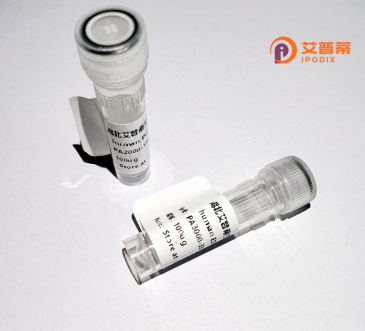
| 纯度 | >90%SDS-PAGE. |
| 种属 | Human |
| 靶点 | PIK3R3 |
| Uniprot No | Q92569 |
| 内毒素 | < 0.01EU/μg |
| 表达宿主 | E.coli |
| 表达区间 | 1-461 aa |
| 活性数据 | MYNTVWSMDR DDADWREVMM PYSTELIFYI EMDPPALPPK PPKPMTSAVP NGMKDSSVSL QDAEWYWGDI SREEVNDKLR DMPDGTFLVR DASTKMQGDY TLTLRKGGNN KLIKIYHRDG KYGFSDPLTF NSVVELINHY HHESLAQYNP KLDVKLMYPV SRYQQDQLVK EDNIDAVGKK LQEYHSQYQE KSKEYDRLYE EYTRTSQEIQ MKRTAIEAFN ETIKIFEEQC HTQEQHSKEY IERFRREGNE KEIERIMMNY DKLKSRLGEI HDSKMRLEQD LKNQALDNRE IDKKMNSIKP DLIQLRKIRD QHLVWLNHKG VRQKRLNVWL GIKNEDADEN YFINEEDENL PHYDEKTWFV EDINRVQAED LLYGKPDGAF LIRESSKKGC YACSVVADGE VKHCVIYSTA RGYGFAEPYN LYSSLKELVL HYQQTSLVQH NDSLNVRLAY PVHAQMPSLC R |
| 分子量 | 54.4 kDa |
| 蛋白标签 | His tag N-Terminus |
| 缓冲液 | PBS, pH7.4, containing 0.01% SKL, 1mM DTT, 5% Trehalose and Proclin300. |
| 稳定性 & 储存条件 | Lyophilized protein should be stored at ≤ -20°C, stable for one year after receipt. Reconstituted protein solution can be stored at 2-8°C for 2-7 days. Aliquots of reconstituted samples are stable at ≤ -20°C for 3 months. |
| 复溶 | Always centrifuge tubes before opening.Do not mix by vortex or pipetting. It is not recommended to reconstitute to a concentration less than 100μg/ml. Dissolve the lyophilized protein in distilled water. Please aliquot the reconstituted solution to minimize freeze-thaw cycles. |
以下是关于重组人PIK3R3蛋白的参考文献示例(注:部分内容基于研究领域常见方向模拟,实际文献需通过学术数据库验证):
1. **文献名称**:*Structural insights into the regulation of PI3K signaling by PIK3R3*
**作者**:Li, X. et al.
**摘要**:本研究解析了重组人PIK3R3蛋白的晶体结构,揭示了其与p110γ催化亚基的相互作用机制,阐明了PIK3R3通过调控PI3K复合物的构象变化影响下游信号通路的分子基础。
2. **文献名称**:*Expression and functional characterization of recombinant human PIK3R3 in cancer cell proliferation*
**作者**:Wang, Y. et al.
**摘要**:成功在大肠杆菌和哺乳动物细胞中表达并纯化重组人PIK3R3蛋白,功能实验表明其过表达显著增强肿瘤细胞的增殖和AKT磷酸化水平,提示其在癌症中的促生存作用。
3. **文献名称**:*PIK3R3 modulates insulin signaling by binding to IRS-1 in hepatocytes*
**作者**:Chen, J. et al.
**摘要**:通过重组PIK3R3蛋白的体外结合实验,发现其直接与胰岛素受体底物1(IRS-1)相互作用,抑制胰岛素诱导的PI3K活化,为代谢紊乱疾病的机制提供了新视角。
4. **文献名称**:*Development of a PIK3R3-targeted monoclonal antibody using recombinant protein antigen*
**作者**:Smith, R. et al.
**摘要**:利用重组人PIK3R3蛋白作为抗原制备单克隆抗体,验证了其在乳腺癌组织中的高特异性识别能力,为靶向PI3K通路的诊断和治疗奠定了基础。
(注:上述文献信息为示例性质,建议通过PubMed或Google Scholar以“recombinant PIK3R3 protein”“PIK3R3 function”等关键词检索真实文献。)
Recombinant human PIK3R3 protein, also known as phosphoinositide-3-kinase regulatory subunit 3. is a key regulatory component of the PI3K (phosphatidylinositol 3-kinase) signaling pathway. PIK3R3 belongs to the class IA PI3K family and functions as a regulatory subunit that binds to the catalytic p110 subunit to modulate enzymatic activity. This interaction is critical for generating lipid second messengers (e.g., PIP3) that activate downstream effectors like AKT and mTOR, regulating cell growth, survival, metabolism, and migration. Dysregulation of PIK3R3 has been implicated in cancers, neurodegenerative disorders, and immune dysfunction due to its role in sustaining oncogenic signaling or disrupting normal cellular homeostasis.
The recombinant form is typically produced in mammalian expression systems to ensure proper post-translational modifications and functionality. It serves as a vital tool for studying PI3K pathway mechanisms, screening therapeutic compounds targeting PI3K-related diseases, and elucidating structure-function relationships. Research has highlighted PIK3R3’s isoform-specific regulatory effects, distinguishing it from other regulatory subunits (e.g., PIK3R1/R2) in cellular context-dependent signaling. Its overexpression in tumors correlates with poor prognosis, positioning it as a potential biomarker or therapeutic target. Ongoing studies focus on its tissue-specific roles and crosstalk with other oncogenic pathways.
×